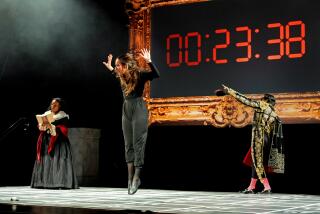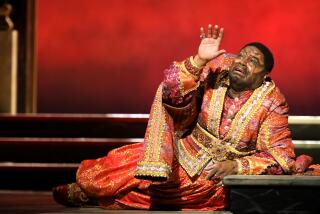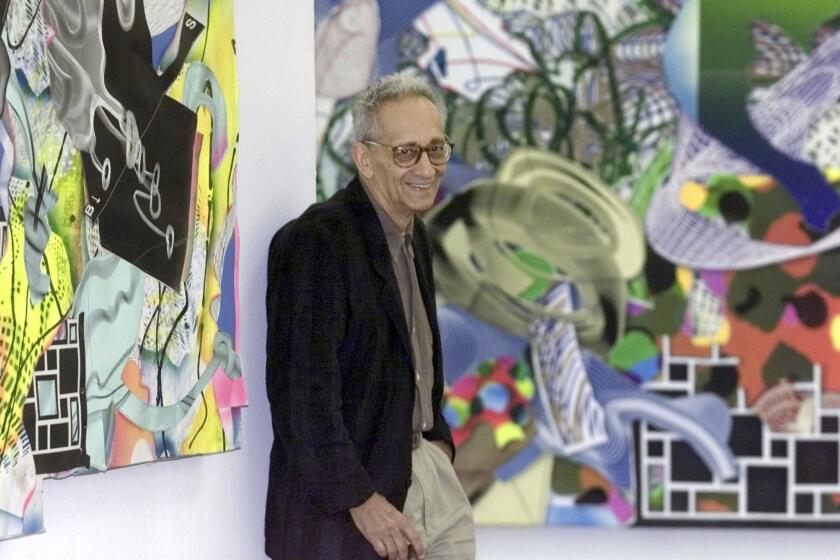Review: With Plácido Domingo and L.A. Opera, ‘Nabucco’ still has the power to provoke
“Nabucco” may take place in biblical times, with the Israelites trying to get out from under Assyrian control, but whenever a group or nation feels the weight of oppression, Verdi’s opera still has something to say today.
Los Angeles Opera audiences first saw “Nabucco” in 2002 in a handsome Elijah Moshinsky production in which cool 21st century visions of electric-blue set walls somehow combined harmoniously with monumental biblical tableaux. It opened the day after Rosh Hashanah and three days before the first anniversary of 9/11 — and there was emotional resonance, to say the least.
Though the names in the headlines have changed since 2002, political allegories (take your pick) were still easy to find when “Nabucco” returned to the Dorothy Chandler Pavilion on Saturday night.
For its second go at “Nabucco,” L.A. Opera turned to director and scenery designer Thaddeus Strassberger’s 2012 Washington National Opera production, which then traveled to Minnesota Opera later that year and to Opera Philadelphia in 2013. The L.A. production delivers the one-two punch of Plácido Domingo (taking on a Verdi baritone role) with superb Verdi conductor James Conlon in the pit.
“Nabucco” was the 28-year-old Verdi’s third extant opera, written reluctantly at first after a crisis of self-confidence brought on by the failure of “Un Giorno di Regno” and the deaths of his first wife and two infant children. It not only made him a star but it also made him a revered symbol of Italian national pride at a time when Italy was still split into a patchwork of city states and regions under Austrian domination.
With that in mind, Strassberger tries to simulate what the opera’s 1842 premiere at La Scala in Milan might have been like, and how it subliminally affected its audiences. Using the old opera-within-a-play trick, he houses the production within the frame of La Scala, with the rumbustious Overture serving as somewhat incongruous background music for gowned, curtsying socialites to be escorted to their tiered box seats to our left, with Austrian soldiers standing guard.
From here, Strassberger pretty much lets the opera play out in its biblical time frame — except when he doesn’t (more on that later). We see massive Babylonian columns, somewhat soiled white robes for the Jewish exiles, colorful garments for the Assyrians, lavishly ornate hand-painted backgrounds.
Within this more-or-less traditional context, three big voices have big outings. In his strictly tenor-role days, Domingo sang the secondary part of Ismaele (he is in peak form on a 1983 “Nabucco” recording), but since 2013, he has been inhabiting the meatier baritone role of Nabucco (Nebuchadnezzar).
On Saturday, we were faced with a tenor still sounding like a tenor in a baritone role, although Verdi is of some help here; the part lies mostly high in the baritone range. But we suspended disbelief, for Domingo used his tremendous acting skills and voice cannily, conserving his energy and peaking at the right time in Part 4 with plenty of sustained power and heartbreaking expression. Don’t listen to the chatter among some opera buffs; he can still bring it.
SIGN UP for the free Essential Arts & Culture newsletter »Almost upstaging the great tenor was Ukrainian soprano Liudmyla Monastyrska as the rafter-rattling Abigaille, a role she also sang at the Met with Domingo as Nabucco in December. She displayed plenty of luster, power-hungry vehemence and just enough agility in this notoriously difficult part, but she also could illuminate the vulnerable side of Abigaille in some delicate controlled passages. Looking like a Nubian prophet, Morris Robinson, who was in the Philadelphia production, unfurled the satisfying, long, rolling tones of a true basso Zaccaria.
In other roles, mezzo-soprano Nancy Fabiola Herrera had some rich, opulent moments as Fenena, tenor Mario Chang sounded a bit underpowered as Ismaele, bass Gabriel Vamvulescu made impressive brief cameos as the stooped, aged High Priest of Baal.
Conlon is one of the best for energetic, militant early Verdi, and he got his orchestra to slash away exuberantly while also taking care to support his singers comfortably in more intimate moments. He also opted for a variant ending — where a moving a cappella chorus came after Abigialle’s death scene instead of before — which I found more effective.
And then there was the chorus, the center of this opera, never more so than in the stroke-of-genius number “Va, pensiero.” This is where Strassberger injected himself into the opera, taking us backstage at La Scala where the Jewish exiles posed like marble sculptures while stagehands changed the sets, seamstresses sewed costumes and others played card games. Taken at a slow pace, “Va, pensiero” sounded elegant and subdued, not particularly rousing.
But I wonder if that was a deliberate attempt to avoid anti-climax, for at the curtain call — as in Washington, D.C., Minneapolis and Philadelphia — there was (spoiler alert) a delightful surprise. Abigaille threw her flowers from the audience contemptuously at the formal folk in the La Scala box, a lone voice struck up “Va, pensiero,” and gradually, everyone in the house joined in, led by Conlon onstage.
I won’t reveal any more details, but Strassberger’s coup de théâtre had an effect, because when it ended, someone in the audience shouted out an expletive insulting President Trump. Yep, “Nabucco” still has the power to provoke.
Support coverage of the arts. Share this article.
MORE NEWS AND REVIEWS
L.A. Opera’s ‘Pearl Fishers’: Stunning production dives deep for meaning
Pancho Villa and the Hubble Space Telescope go on operatic adventures
MacArthur fellow Yuval Sharon: Opera’s man of the moment
More to Read
The biggest entertainment stories
Get our big stories about Hollywood, film, television, music, arts, culture and more right in your inbox as soon as they publish.
You may occasionally receive promotional content from the Los Angeles Times.






